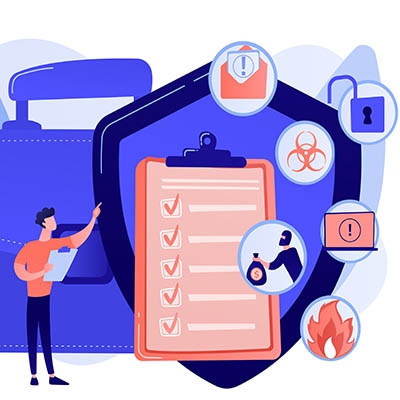The first step is to determine what we mean when we say “business continuity,” especially in the wake of the COVID-19 pandemic.
What is Business Continuity?
There is no shortage of things that can go wrong for a business. Natural disasters, power outages, fires, floods, hacking attacks, ransomware, and user error can all contribute to a significant disruption of operations if you’re unprepared for them. A business continuity plan is designed to help your organization work through any such disaster and keep downtime to a minimum. We want to emphasize that business continuity and disaster recovery are two different things; disaster recovery, or how your organization responds to a data loss incident, is but one part of a successful business continuity plan.
Components of a Business Continuity Strategy
Before we jump into what your priorities are for your business continuity strategy, it helps to perform what’s called a business impact analysis. This is a test that determines what the critical functions of your business are, where you take a close look at operations and make determinations about what is most important for getting back in business following a disaster. By having a clear understanding of your priorities regarding business continuity, you will optimize your chances of success should you ever find yourself implementing the plan.
While we could list off several aspects of business continuity here, suffice to say that most variables to consider for your plan will fall into one of the three categories below:
- Digital resources: Data is critical to the operations of most businesses to at least some degree. Some organizations store it on-premises while others store it in the cloud. Regardless, having a way to maintain access and recover lost data in the event of a disaster will be paramount to your plan’s success.
- Human resources: While the data might be one part of keeping your business afloat, the people who interpret and utilize that data also must be accounted for. A chain of command can help your organization even should the leader somehow become incapacitated or unable to perform in their role. Furthermore, you’ll need to maintain contact with clients and vendors to ensure they are fully aware of the situation.
- Physical resources: Once you have safeguarded your data and your workers, you’ll need to figure out where they will work and how it will be housed. Physical resources include things like your office space, hardware solutions, and any other tools your employees might need to do their jobs. In the case of manufacturing, this might mean maintaining the supply chain for parts or products.
All things considered, your business continuity strategy should consider everyone needed to keep your business in proper working order, as well as all of the resources they require to do their jobs effectively and efficiently. We especially recommend that you have your business continuity plan in a location where it is accessible by anyone who might need it, along with a list of critical equipment, the locations of your data backups, and any needed contact information.
How Do You Reinforce Business Continuity?
Remember, your plan is only valuable if it is something that can be executed on. Consider how easy (or difficult) it will be for you to successfully implement your strategy. If you do a “mock” test of your plan, you might uncover what works, what doesn’t, and what needs to be improved upon. When you routinely test your strategy, you won’t be caught off guard. Here are some ideas to consider for when you test your business continuity plan:
- Downtime: Does your plan meet the expected minimum of downtime? Does it keep costs down?
- Implementation: Is your plan something that can be implemented at a moment’s notice?
- Feedback: What do your staff think about the plan? Do they have any recommendations or ideas for improvement?
Let’s Get You Started
If this all feels a little overwhelming or panic-inducing, we urge you to contact COMPANYNAME. We can walk you through the process of setting up a business continuity plan, equip your organization with the tools needed to pull it off, and assist with the testing process. To learn more, reach out to us at PHONENUMBER.
